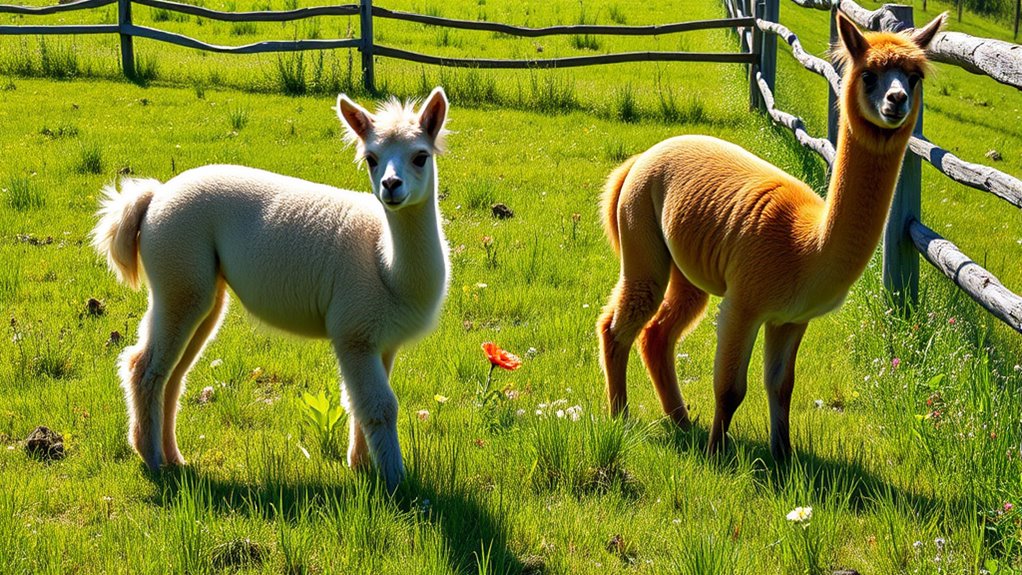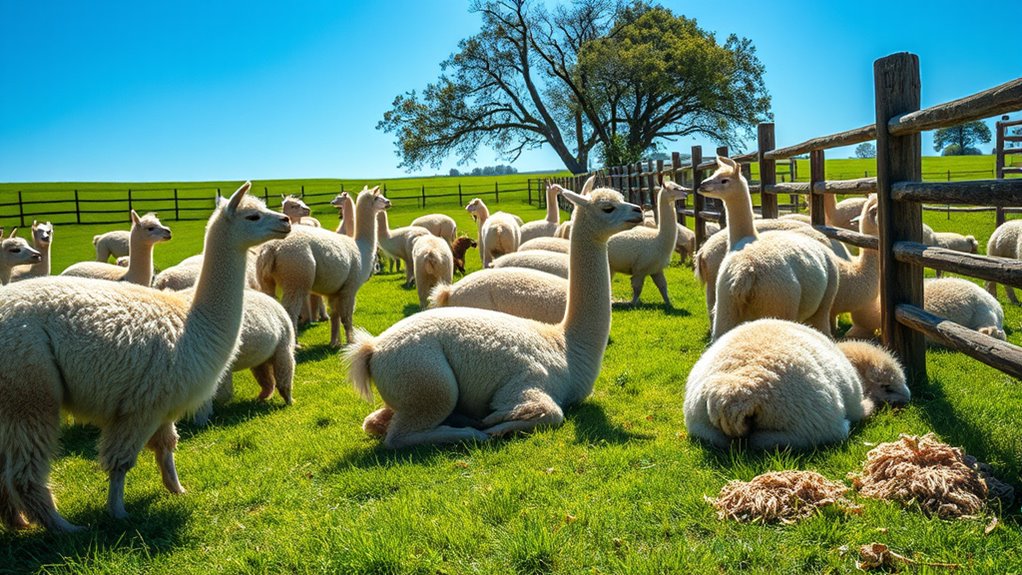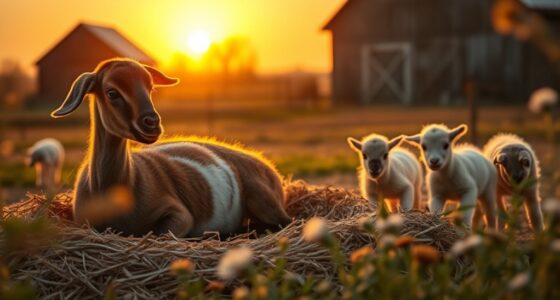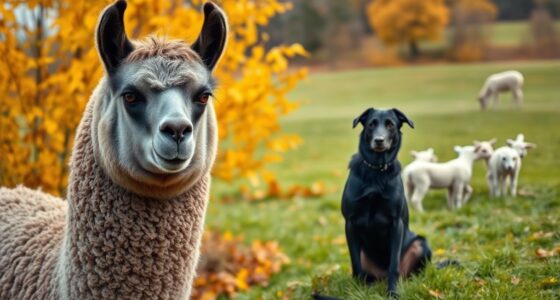To guarantee ideal fiber production and pasture health, you should shear alpacas and llamas annually in spring using proper techniques to reduce stress and skin issues. Feed them a balanced diet with quality forage, supplemented during growth and pregnancy, and rotate pastures regularly to prevent overgrazing. Monitoring their health and body condition helps maintain fiber quality and overall well-being. Keep learning how to refine their care for the best results.
Key Takeaways
- Regular annual shearing in spring maintains fiber quality and animal comfort while preventing skin issues.
- A balanced diet with high-quality forage, supplemented as needed, supports optimal fiber growth and overall health.
- Pasture rotation and management promote healthy grazing, prevent overgrazing, and ensure continuous access to nutritious forage.
- Providing fresh water and mineral supplements is essential for proper fiber development and animal well-being.
- Monitoring body condition and health during shearing and seasons ensures optimal fiber production and overall care.

Are you considering caring for alpacas or llamas? If so, you’ll need to understand how to manage their fiber production and meet their pasture needs effectively. One of the most critical aspects of fiber management is shearing techniques. Alpacas and llamas produce valuable fleece that must be harvested carefully to ensure their health and comfort. Proper shearing involves more than just cutting; it requires skill and timing. You should schedule shearing once a year, typically in the spring, to prevent overheating during warmer months. Using sharp clippers and gentle handling minimizes stress and potential injuries. It’s best to work with experienced shearers or learn proper techniques yourself, focusing on avoiding cuts and ensuring a smooth, even removal of fleece. After shearing, you can assess the quality of the fiber and prepare it for processing or sale. Remember, shearing isn’t just about fiber collection—it’s also an opportunity to check the animal’s overall health, inspecting for skin issues or parasites. Additionally, maintaining proper shearing tools and hygiene helps prevent infections and ensures a clean cut. Beyond fiber management, dietary management plays an essential role in maintaining healthy alpacas and llamas. These animals have specific nutritional needs that should be met with a balanced diet. High-quality forage, such as grass or hay, forms the foundation of their diet and should be available at all times. Supplementing with grains or pelleted feed might be necessary if your animals are growing, pregnant, or lactating, but overfeeding can lead to obesity and other health problems. Always provide fresh, clean water to keep them hydrated, especially during hot weather. Additionally, mineral supplements tailored for camelids can help prevent deficiencies in essential nutrients like selenium and zinc. Proper dietary management also involves adjusting their intake based on seasonal changes and pasture availability. During winter or dry seasons, you might need to increase hay or introduce supplements to compensate for less grazing. Rotating pastures is another best practice, preventing overgrazing and promoting healthy land use. Regularly monitoring your animals’ body condition score helps you gauge whether they’re getting enough nutrition or if adjustments are necessary. Avoid sudden dietary changes, which can upset their digestion, and always consult with a veterinarian or an experienced camelid nutritionist to develop a feeding plan suited to your animals’ specific needs. Ensuring proper fiber quality and pasture management will help promote optimal fiber production and overall health. Caring for alpacas and llamas requires a combination of proper shearing techniques and meticulous dietary management. By doing so, you ensure they stay healthy, produce quality fiber, and enjoy a comfortable, stress-free life. Paying close attention to these aspects will help you build a sustainable and rewarding relationship with your herd, whether your goal is fiber production, companionship, or breeding.
Frequently Asked Questions
What Are the Signs of Illness in Alpacas and Llamas?
You should look for symptom identification and veterinary signs of illness in alpacas and llamas. Watch for changes in appetite, unusual behavior, or lethargy. Monitor their respiration and check for nasal discharge, swelling, or limping. A sudden drop in fleece quality or abnormal droppings can also indicate health issues. If you notice these signs, consult a veterinarian promptly to guarantee proper care and treatment.
How Do I Introduce New Animals to My Herd?
To introduce new animals to your herd, use gentle introduction techniques like gradually mixing them in a neutral space first. Observe herd socialization closely, ensuring the new animals are accepted without aggression. Keep an eye out for signs of stress or rejection, and give everyone time to adjust. Maintaining calm, consistent routines helps ease the progression, promoting healthy herd dynamics and minimizing conflict during the introduction process.
What Are the Common Parasites Affecting Alpacas and Llamas?
You should be aware that common parasites like gastrointestinal worms and lice can affect your alpacas and llamas. To prevent these issues, practice regular parasite prevention through deworming and monitoring. Additionally, implementing pasture rotation helps reduce parasite loads by breaking their life cycle. Regular checks and maintaining clean, dry living areas also minimize parasite risks, ensuring your herd stays healthy and productive.
How Do I Handle Aggressive Behavior in These Animals?
Ever wonder how to tame a fiery spirit? You handle aggressive behavior by observing herd dynamics and implementing consistent behavior management. Stay calm and assertive, giving the animal clear boundaries. Use positive reinforcement to encourage calmness, and make sure they feel secure within their herd. Redirect aggressive energy with gentle, firm commands, and avoid sudden movements. Patience and understanding help turn aggression into trust, strengthening your bond with your alpacas or llamas.
What Are the Best Methods for Trimming Their Fiber?
To perform fiber trimming effectively, you should use proper grooming techniques like sharp scissors or clippers designed for alpacas and llamas. Start by calming your animals and handling their fiber gently. Trim excess or matted fibers carefully, avoiding the skin. Regular grooming keeps the fiber healthy and manageable. Be patient and gentle, ensuring your animals feel comfortable throughout the process. Proper fiber trimming enhances their comfort and fiber quality.
Conclusion
Taking good care of your alpacas and llamas guarantees healthy fiber and happy animals. Providing proper pasture, nutrition, and regular grooming keeps them thriving. Remember, isn’t their well-being worth the effort? By understanding their needs and meeting them consistently, you’ll enjoy a rewarding experience with these gentle creatures. So, are you ready to give your herd the care they deserve and reap the benefits of their beautiful fiber? Your journey starts now.










